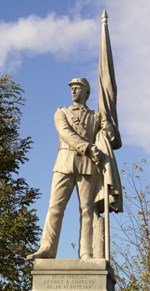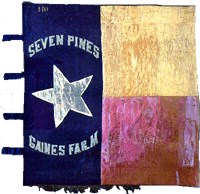

Texas State Library and Archives
Abolitionist Henry Ward Beecher wrote during the war about what his flag represented. “A thoughtful mind, when it sees a nation’s flag, sees not the flag only, but the nation itself; and whatever may be its symbols, it insignia, he reads chiefly in the flag the government, the principles, the truths, and the history which belongs to the nation that sets it forth.” Thankfully our nation’s flag was carried forth through four years of horrific struggle to reunification. As Jerome Watrous, a veteran of the 6th Wisconsin Infantry reflected, “We realized after Appomattox that the lives of thousands of our comrades who had died on battle fields had in a way been woven into our colors. Then we realized that it was equally true that we have been woven into the colors. It was not only our flag, the flag of our country, but that we were part of it. We had helped to cleanse it; we had given the new-born nation a new and clean flag. The old, faded, torn, furled flags are sacred remnants of the new-born nation’s untarnished emblem.”
Back in South Carolina when Mattie Brunson heard her father’s stories about his flag she asked, “Who was Baxter Rollins?” Private Rollins, answered Joseph, was the sixteen-year-old color bearer for the battery. While serving the battery at Antietam, a piece of artillery shell knocked him down and mortally wounded him just as he fired the cannon. The wheels of the gun rolled over and crushed his feet. Crippled and dying, the men tried to carry Baxter to the rear. With tears in his eyes he said, “Don’t take me to the rear boys, carry me to my flag. I know I must die, and I want to die by my flag.”

|
Last updated: September 15, 2023
